- After four straight weeks of losses, wheat hits near one-month high
- Wheat’s peak comes on news that U.S. and German tanks are to roll into Ukraine
- If the upside stays, wheat’s extended rally could begin at $8 and run to $9.50
After four weeks in the red, wheat prices have hit their highest in almost a month as grain traders react to the news that U.S. and German tanks were to roll into Ukraine amid bigger reinforcements planned by Washington to assist President Volodymyr Zelenskyy’s army against Russia’s invasion.
The front-month wheat contract on the CBOT, or Chicago Board of Trade, peaked at $7.666 a bushel in Tuesday’s session as trading concluded for January. The last time a benchmark U.S. wheat contract was higher was on Jan. 4, when it reached 7.805 per bushel.

Charts by SKCharting.com, with data powered by Investing.com
The upshot for wheat follows weekly losses since Jan. 7 in a market that has slid to almost pre-Ukraine war pricing over the past year. The grain’s near one-month high coincides with news on Wednesday that U.S. President Joe Biden and German Chancellor Olaf Scholz will send contingents of tanks to Ukraine.
While the effectiveness of the German Leopard 2 and U.S. M1 Abrams tanks have been disputed, the decision to send them represents a reversal of U.S. and German hesitation at providing Kyiv with offensive armored vehicles. It is also symbolic of efforts by Zelenskyy’s allies to help Ukraine recover territory seized by Russia. Some 321 tanks will be received by Ukraine, Kyiv’s ambassador to France, Vadym Omelchenko, said.
Aside from the tanks, the United States is separately preparing more than $2 billion worth of Ukrainian military aid that is expected to include longer-range rockets for the first time as well as other munitions and weapons, Reuters reported on Tuesday.
U.S. Wheat Associates, an export market development organization that supports the wheat industry, said in an outlook issued this week:
“Market sentiment has become increasingly bearish, and prices have significantly dipped in the buyer’s favor; however, many unknowns linger in the market. The underlying uncertainty of Putin’s war will continue to support the market.”
Jack Scoville, Chief Crop Analyst at the Price Futures Group in Chicago, concurred, saying:
“The US and Germany are about to supply tanks to Ukraine, allowing the war to get hotter while the wheat crop develops.”
Adds Scoville:
“Russia has a large wheat production, although the USDA (US Department of Agriculture) says it is not nearly as large as Russia says it is. The big Russian production goes against the difficulty of moving the grain from the Black Sea due to insurance requirements, But so far, the lack of insurance has not increased demand for US wheat as Russian wheat is still moving.
The demand for US wheat in international markets has been a disappointment all year and has been hindered by low prices and aggressive offers from Russia. Ukraine is also looking for new business for its crops, and Russia is aggressive in the world market as it looks for cash to fund the war.”
CBOT wheat got to a record high of $13.62 right after the Ukraine invasion. Following a year of dramatic volatility, several factors have pressured global wheat prices back to levels seen before the invasion.
Prices have steadily crumbled since the summer of last year after Russia and Ukraine, with support from the United Nations and Turkey, agreed to the Black Sea grain corridor and created the JCC, or Joint Coordination Center, to facilitate exports for the region. The agreement allowed supplies trapped in Russia and Ukraine to re-enter the world market, and in response, wheat futures eased 37% from the spring’s highs.
“In the months since the corridor was implemented, wheat futures have continued falling to pre-war levels,” U.S. Wheat Associates said. “The downward pressure of steady, low-priced Black Sea wheat exports remains the primary driver.”
According to JCC data, since the corridor’s inception, 5.1 million tonnes of wheat have been shipped from Ukraine.
The USDA’s January report on World Agricultural Supply and Demand Estimates has pegged Russian wheat production at 91 million tonnes, though some private sector forecasts are upwards of 104 million tonnes. With record production, Russian exports are expected to reach 43 million tonnes, 17% above the five-year average.
A record crop from Australia has also helped ease some global supply concerns. The Australian wheat crop is rumored to reach nearly 42 million tonnes, though USDA estimates hover at 36.6 million tonnes.
So, where are wheat prices headed in the near term?

Technical charts are pointing to an extended rally that could begin at $8 and run up to $9.50, says Sunil Kumar Dixit, chief technical strategist at SKCharting.com.
“Though wheat futures has been showing an up move for the second week back to back, its extent may be limited for now to the $8.00-$8.13-$8.26 range.
Only if prices gain strong acceptance above this resistance zone, a further up-leg will begin, targeting $9.50 with some momentum distribution between $8.50 and $8.80.”
If wheat fails to establish itself above $8, prices are likely to drop to the recent low of $7.12 and extend its downside to the 200-week SMA, or Simple Moving Average, of $6.76, Dixit concludes.
Disclaimer: Barani Krishnan uses a range of views outside his own to bring diversity to his analysis of any market. For neutrality, he sometimes presents contrarian views and market variables. He does not hold positions in the commodities and securities he writes about.
